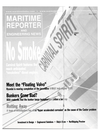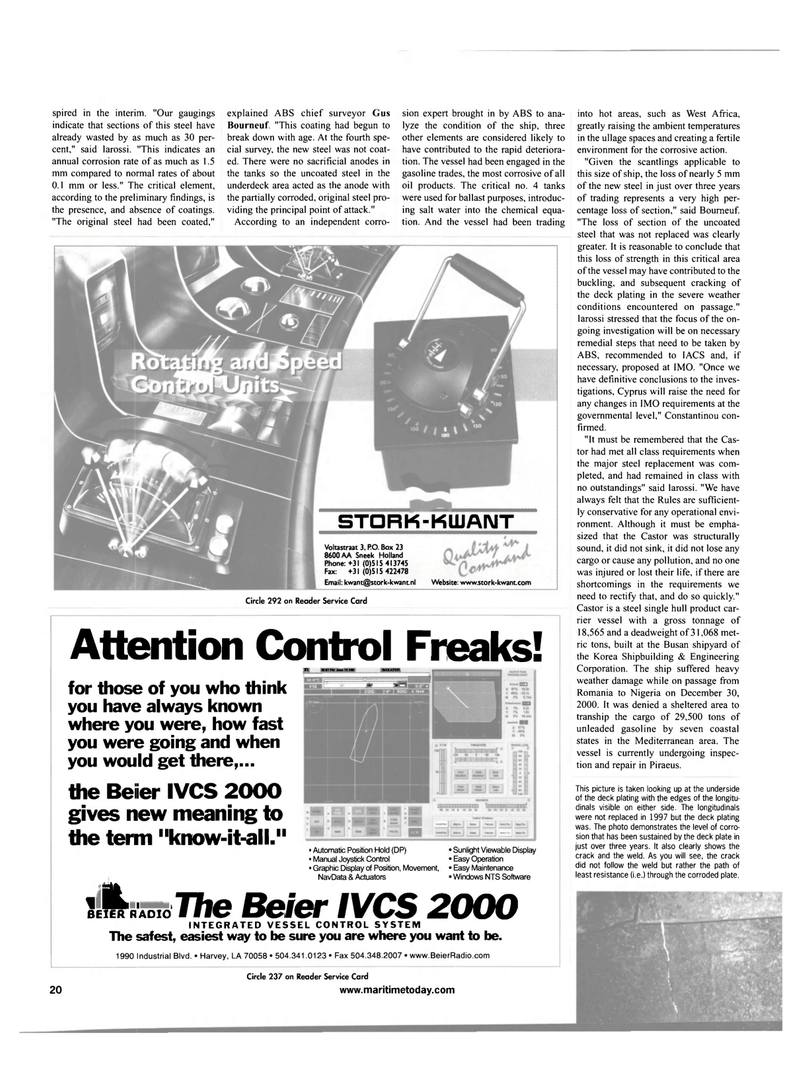
Page 20: of Maritime Reporter Magazine (May 2001)
Read this page in Pdf, Flash or Html5 edition of May 2001 Maritime Reporter Magazine
spired in the interim. "Our gaugings indicate that sections of this steel have already wasted by as much as 30 per- cent," said larossi. "This indicates an annual corrosion rate of as much as 1.5 mm compared to normal rates of about 0.1 mm or less." The critical element, according to the preliminary findings, is the presence, and absence of coatings. "The original steel had been coated," explained ABS chief surveyor Gus
Bourneuf. "This coating had begun to break down with age. At the fourth spe- cial survey, the new steel was not coat- ed. There were no sacrificial anodes in the tanks so the uncoated steel in the underdeck area acted as the anode with the partially corroded, original steel pro- viding the principal point of attack."
According to an independent corro- sion expert brought in by ABS to ana- lyze the condition of the ship, three other elements are considered likely to have contributed to the rapid deteriora- tion. The vessel had been engaged in the gasoline trades, the most corrosive of all oil products. The critical no. 4 tanks were used for ballast purposes, introduc- ing salt water into the chemical equa- tion. And the vessel had been trading into hot areas, such as West Africa, greatly raising the ambient temperatures in the ullage spaces and creating a fertile environment for the corrosive action. "Given the scantlings applicable to this size of ship, the loss of nearly 5 mm of the new steel in just over three years of trading represents a very high per- centage loss of section," said Bourneuf. "The loss of section of the uncoated steel that was not replaced was clearly greater. It is reasonable to conclude that this loss of strength in this critical area of the vessel may have contributed to the buckling, and subsequent cracking of the deck plating in the severe weather conditions encountered on passage." larossi stressed that the focus of the on- going investigation will be on necessary remedial steps that need to be taken by
ABS, recommended to IACS and, if necessary, proposed at IMO. "Once we have definitive conclusions to the inves- tigations, Cyprus will raise the need for any changes in IMO requirements at the governmental level," Constantinou con- firmed. "It must be remembered that the Cas- tor had met all class requirements when the major steel replacement was com- pleted, and had remained in class with no outstandings" said larossi. "We have always felt that the Rules are sufficient- ly conservative for any operational envi- ronment. Although it must be empha- sized that the Castor was structurally sound, it did not sink, it did not lose any cargo or cause any pollution, and no one was injured or lost their life, if there are shortcomings in the requirements we need to rectify that, and do so quickly."
Castor is a steel single hull product car- rier vessel with a gross tonnage of 18,565 and a deadweight of 31,068 met- ric tons, built at the Busan shipyard of the Korea Shipbuilding & Engineering
Corporation. The ship suffered heavy weather damage while on passage from
Romania to Nigeria on December 30, 2000. It was denied a sheltered area to tranship the cargo of 29,500 tons of unleaded gasoline by seven coastal states in the Mediterranean area. The vessel is currently undergoing inspec- tion and repair in Piraeus.
This picture is taken looking up at the underside of the deck plating with the edges of the longitu- dinals visible on either side. The longitudinals were not replaced in 1997 but the deck plating was. The photo demonstrates the level of corro- sion that has been sustained by the deck plate in just over three years. It also clearly shows the crack and the weld. As you will see, the crack did not follow the weld but rather the path of least resistance (i.e.) through the corroded plate.
Circle 292 on Reader Service Card
Attention Control Freaks! for those of you who think you have always known where you were, how fast you were going and when you would get there,... the Beiier IVCS 2000 gives mew meaning to the term "know-it-all.11
Q 38.07 PM Jon* IS ZOO n-
KUIATOR
M" 1 rm • Automatic Position Hold (DP) • Sunlight Viewable Display • Manual Joystick Control • Easy Operation • Graphic Display of Position, Movement, • Easy Maintenance
NavData & Actuators • Windows NTS Software
Ie^'r'adio Be/er IVCS 2000
INTEGRATED VESSEL CONTROL SYSTEM
The safest, easiest way to be sure you are where you want to be. 1990 Industrial Blvd. • Harvey, LA 70058 • 504.341.0123 • Fax 504.348.2007 • www.BeierRadio.com
STDRK-K11JANT
Voltastraat 3, P.O. Box 23 8600 AA Sneek Holland
Phone: +31 (0)515 413745
Fax: +31(0)515 422478
Email: [email protected] Website: www.stork-kwant.com 20
Circle 237 on Reader Service Card www.maritimetoday.com

 19
19

 21
21
